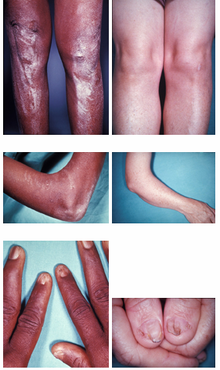Osteoonychodysplasia
| Classification according to ICD-10 | |
|---|---|
| Q87.2 | Congenital malformation syndromes with predominant involvement of the extremities |
| ICD-10 online (WHO version 2019) | |
The nail-patella syndrome (syn. Hereditary Onychoosteodysplasie, Turner-Kieser syndrome , Trauner-Rieger syndrome , nail-patella syndrome ) is an autosomal dominant hereditary disease , which is associated with various deformities and organ dysfunction. A partial complex associated with deformation of the fingernails and bones is also known as the nail-patella syndrome . The disease is observed worldwide.
The malformation occurs about once in 50,000 newborns, with the same frequency in boys and girls. It is often fatal in infancy due to chronic kidney failure. The diagnosis is suspected with imaging tests and confirmed with a kidney biopsy. Corticoids and diuretics are used for treatment, and dialysis is used in advanced cases . Causal treatment is only possible with a kidney transplant.
The American John Turner, the German Willibald Kieser, the Austrians Richard Trauner and Herwigh Rieger, and several other doctors published case studies of this hereditary disease in the 1920s and 1930s.
causes
The cause of the disease is a mutation in the LMX1B gene .
Symptoms
In the nail-patella syndrome, the fingernails (less often the toenails) are usually deformed, too small ( nail hypoplasia ) or missing (nail aplasia). The kneecaps are also usually too small or nonexistent. Life expectancy in people with nail patella syndrome is not reduced.
In the case of osteoonychodysplasia, dysplastic elbows (e.g. radial head dislocations), curvature of the spine ( scoliosis ) and exostoses on the iliac bones ("pelvic horns") can occur in the skeleton . There are various types of extension inhibition as well as hand and foot deformations ( club feet ).
In addition, organic disorders such as renal insufficiency (in 50% of affected people), glaucoma and cardiac arrhythmias can occur.
literature
- SD Dreyer, G. Zhou, A. Baldini, A. Winterpacht, B. Zabel, W. Cole, RL Johnson, B. Lee: Mutations in LMX1B cause abnormal skeletal patterning and renal dysplasia in Nail Patella Syndrome. In: Nat Genet . 1998, 19, pp. 47-50.
- I. McIntosh, SD Dreyer, MV Clough, JA Dunston, W. Eyaid, CM Roig, T. Montgomery, Ala Mello S, Kaitila I, Winterpacht A, Zabel B, Frydman M, Cole WG, Francomano CA, Lee B: Mutation analysis of LMX1B gene in Nail-Patella syndrome patients. In: Am J Hum Genet. 1998, 63, pp. 1651-1658.
- SD Dreyer, R. Morello, MS German, B. Zabel, A. Winterpacht, GP Lunstrum, WA Horton, KC Oberg, B. Lee: LMX1B transactivation and expression in nail-patella syndrome. In: Hum Mol Genet . 2000, 9, pp. 1067-1074.
- R. Morello, G. Zhou, D. Dreyer, SJ Harvey, Y. Ninomiya, PS Thorner, JH Miner, W. Cole, A. Winterpacht, B. Zabel, KC Oberg, B. Lee: Regulation of glomerular basement membrane collagen expression by LMX1B contributes to renal disease in nail patella syndrome. In: Nat Genet. 2001, 27, pp. 205-208.
